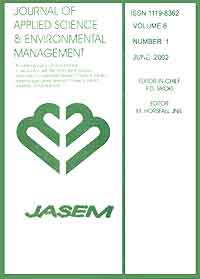
|
Journal of Applied Sciences and Environmental Management
World Bank assisted National Agricultural Research Project (NARP) - University of Port Harcourt
ISSN: 1119-8362
Vol. 11, No. 2, 2007, pp. 169-172
|
 Bioline Code: ja07043
Bioline Code: ja07043
Full paper language: English
Document type: Research Article
Document available free of charge
|
|
|
Journal of Applied Sciences and Environmental Management, Vol. 11, No. 2, 2007, pp. 169-172
| en |
Influence of Hudiara Drain Water Irrigation on Trace Elements Load In Soil And Uptake By Vegetables
Yamin, Muhammad Tariq & Ahmad, Nasir
Abstract
The rapid urbanization in the cities and increasing load of population generating lot of problems for
maintaining environment. The sewage and industrial effluent generated by human settlement are disposed of directly in
to nearby rivers / water bodies and agricultural fields. This polluted water not only contains organic matter and crop
nutrients but also some toxic metals. The water of these channels may become a potential source of diseases and
contaminate our natural resources. In Pakistan it is a common practice to use industrial and sewage effluents for raising
crops. Continuous use of such effluent could result in accumulation of metals to such a concentration that may become
phytotoxic and eventually hazardous to animal and human health. One such example is the Hudiara drain; a
transboundary channel originates from India and enters in Pakistan at village Laloo. Farmers of nearby locality are using
the untreated waste water for raising the crops and vegetables. This practice is being done at more than 4000 acres of
cultivated area along the Drain by lifting the drain’s water through electric pumps, peter engines and tractor driven
devices. The density of tubewells is 7 pumps per kilometres for irrigating the farmer’s fields and it is increasing day by
day. Three points were selected for sampling the vegetables along the 54.6 km stretch of drain, each at head, middle and
tail. Soil samples were taken before sowing and after the harvesting of crops. Plant samples were collected at maturity
from all the monitoring points. At each location samples were collected at four nearby sites for detail and representative
analysis. During the growing period of crop regular monitoring of Hudiara drain was done for water quality parameters.
It was found that metal ions concentration in the vegetables was higher as specified in the standards. Similarly water
quality of drain showed increasing level of Residual Sodium Carbonate (RSC), Sodium Adsorption Ratio (SAR) and
Electrical Conductivity (EC) as recommended in the water quality criteria. Dissolved Oxygen (DO), Chemical Oxygen
Demand (COD) and Biological Oxygen Demand (BOD) requirements of Drain water were also found higher than the
National Environmental Quality Standards (NEQS) established under the Pakistan Environmental Protection Act, 1997.
It was concluded that continuous use of untreated drain’s water is not suitable for raising agricultural crops due to its
consequences on human health and soil environment.
|
| |
© Copyright 2007 - Journal of Applied Sciences & Environmental Management
|
|
